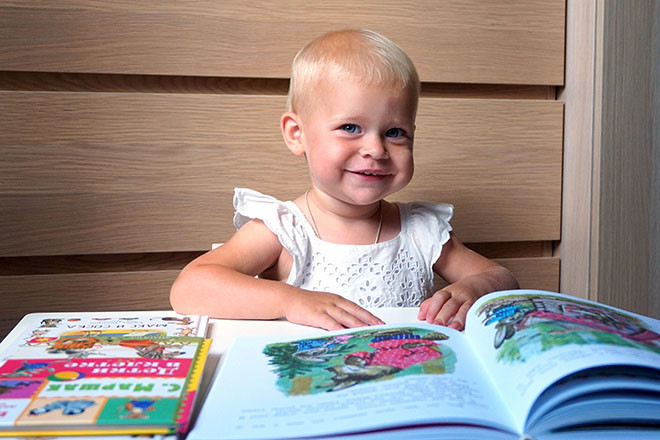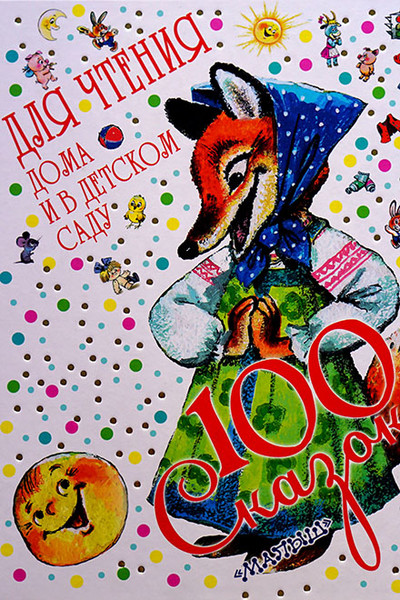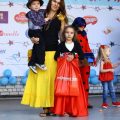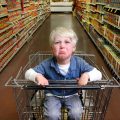 A photo: Olga Eremina The measured hot days this year are rapidly replaced by gusts of wind and thunderstorms, which means that there is time to rest from the heat, stay at home and spend half an hour reading. And in fact to the smallest readers it is longer also it is not necessary.
A photo: Olga Eremina The measured hot days this year are rapidly replaced by gusts of wind and thunderstorms, which means that there is time to rest from the heat, stay at home and spend half an hour reading. And in fact to the smallest readers it is longer also it is not necessary.
Samuel Marshak. "Children in a cage"; publishing house "AST"
I have a small hardback book in my hands.colorful cover. We are just planning our first trip to the zoo, and this book will be a great hint for the child. Before and right after visiting the zoo, it will help the baby remember new animals. Small quatrains are dedicated to a variety of animals. Turning the pages, we move from one enclosure to another. We look at the black and white zebras, which are lined like school notebooks, watch the polar bears swimming in a spacious pond with cool and fresh water. In such a hot summer, we can only envy them. A kangaroo will quickly gallop past us, and a brown bear will put on a real show, of course, expecting a treat in return. The second part of the book is an alphabet in verses and pictures. I can’t say that I strive to raise a child prodigy and teach my daughter to read before she’s 2 years old, so before there was not a single alphabet in our library. But in this book we were happy to look at all the letters, read funny poems. For the first acquaintance this is more than enough. The illustrations in the book brought back good memories of my childhood. All the animals are endowed with emotions, they literally live on the pages. My daughter laughed, seeing how the bear was happily splashing in the water, she was happy to look at the unusual penguins with penguin chicks. We were happy to put the book on our shelf and recommend it to children from 1.5 years old. But it will remain relevant for a long time, the child will be able to learn letters and short rhythmic poems from it.
"One hundred tales for reading at home and in kindergarten", the collective of authors; publishing house "AST"
 A photo: Olga Eremin If you are going on a trip or to the country house and take a lot of books with you hard, grab this one! A wonderful collection of fairy tales for kids. To be fair, I will say that inside the book there are not 100 fairy tales, this is the name of the whole series. But there are a lot of them, and they are diverse. This is the well-known "Kolobok", and "Zayushkina Hut", and "Geese-swans", and "Little Red Riding Hood". In addition, it has poems by famous children's writers and modern tales. Together with clever little animals your baby learns how important it is to follow the rules of the road, how dangerous it is to be alone among cars. And next time, perhaps it will be easier for you to transfer the child by the hand through the carriageway. And it's impossible to not empathize with a small cunning little mouse from Marshak's tale. Show the baby, as small as he himself, the mouse cleverly escaped all troubles and was able to return home to his mother. A brave Cockerel - a red comb will save the bunny from Goat-tree and from Fox and return the hut to him in two fairy tales. Illustrations in the book are also wonderful. At the same time, they are very different in style and technique, even in the palette of colors, but they are invariably beautiful and interesting for study. I was surprised when I saw that all the fairy tales were illustrated by one artist. Savchenko illustrated many Soviet cartoons, including the fairy tale "Petya and Little Red Riding Hood." I recommend this book to children of a very wide age category. It can be interesting even to the smallest readers. Although for some long tales of assiduity and attention so far may not be enough. But in the future the child will be able to use the book for independent reading.
A photo: Olga Eremin If you are going on a trip or to the country house and take a lot of books with you hard, grab this one! A wonderful collection of fairy tales for kids. To be fair, I will say that inside the book there are not 100 fairy tales, this is the name of the whole series. But there are a lot of them, and they are diverse. This is the well-known "Kolobok", and "Zayushkina Hut", and "Geese-swans", and "Little Red Riding Hood". In addition, it has poems by famous children's writers and modern tales. Together with clever little animals your baby learns how important it is to follow the rules of the road, how dangerous it is to be alone among cars. And next time, perhaps it will be easier for you to transfer the child by the hand through the carriageway. And it's impossible to not empathize with a small cunning little mouse from Marshak's tale. Show the baby, as small as he himself, the mouse cleverly escaped all troubles and was able to return home to his mother. A brave Cockerel - a red comb will save the bunny from Goat-tree and from Fox and return the hut to him in two fairy tales. Illustrations in the book are also wonderful. At the same time, they are very different in style and technique, even in the palette of colors, but they are invariably beautiful and interesting for study. I was surprised when I saw that all the fairy tales were illustrated by one artist. Savchenko illustrated many Soviet cartoons, including the fairy tale "Petya and Little Red Riding Hood." I recommend this book to children of a very wide age category. It can be interesting even to the smallest readers. Although for some long tales of assiduity and attention so far may not be enough. But in the future the child will be able to use the book for independent reading.
Sergey Mikhalkov. "Poems to the kids"; publishing house "AST"
We already had poems in our home librarySergei Mikhalkov. And finally, a whole collection of his works has appeared, which I am very happy about. They are truly interesting to read even for adults, they always have meaning, a plot, often instructive thoughts and humor. You read the book to a child and remember how in childhood in the summer you dreamed of a bicycle sparkling in the sun, and in the winter - of a fast sled with shiny runners or endlessly and often unsuccessfully begged your parents for a puppy. And you understand how easy it is to make a child happy, because childhood really only happens once. Leafing through the pages of the book, we will count the colorful kittens, together with the girl Lyuba we will think about how important it is to take care of your teeth, we will ride along the path on a two-wheeled bicycle. And we will also remember that in order to see the most amazing miracles, sometimes it is enough to press your cheek tightly to the pillow and fall asleep. These poems, of course, are not for the youngest readers, they are quite long. These are no longer primitive quatrains, but entire stories in poetic form. Perhaps the age of potential readers explains the illustrations. Frankly, they seemed gloomy and a bit primitive to me, I wanted more interesting drawings for such wonderful poems. Although some of the pictures are made as if they were drawn by a child, which may interest children. But overall, the book is excellent, and we will be happy to read it again and again, as soon as we grow up a little.
Barbro Lindgren. "Max and diaper"; publishing house "Samokat"
Let me start with the fact that the book is small in format.It is very easy for a baby to hold it in his hands and turn the pages. The bright cover, where almost all the characters are already familiar to my child, made me happy and gave hope that my daughter would like the book. Moreover, this topic is close and understandable to every mother and child. Having read reviews that the book has been successfully sold all over the world for a long time and is even recommended by a speech therapist, we got ready to read. Honestly, I was disappointed. Personally, I do not understand the meaning at all. What does this book teach a child? Little Max does not want to pee in a diaper and gives it to the dog, and he himself pees on the floor. His mother catches him doing this. That is, the child will not be able to get any useful skills from the book. The only positive thing for me is that Max himself wiped the puddle on the floor. I can explain the recommendations for reading this book to children only by the fact that the topic is familiar to every child. The sentences are very simple and short, they are easy to understand and remember. Maybe I look at it from an adult's point of view, but children will like the book. My daughter looked at the pictures with great interest. But I don't see any benefit for my child. We read it a couple of times, and that's it.
Barbro Lindgren. "Max and the nipple"; publishing house "Samokat"
The second book in the same series disappointed me,perhaps even more. The book tells us how much a baby loves his pacifier. He goes for a walk and meets a dog, a cat and a duck in turn. And he shows his pacifier to everyone, bragging. And when a nimble duck takes it away, he hits the bird on the head and takes the pacifier back. After which the duck gets angry, and Max is very happy. I honestly did not understand what this book was supposed to teach. My daughter looked at the picture for a long time where Max hit the duck on the head. The child did not let me turn the page and, pointing at the duck with his finger, repeated that it hurt. We barely calmed her down and carried her away with another book. In my opinion, the book will not help those parents who want to wean their baby off the pacifier, and in general it has a very peculiar meaning. I find it difficult to even answer to whom I could recommend it.
Ekaterina Murashova. "Your incomprehensible child"; publishing house "Samokat"
 Photo:Olga EreminaAnd one more book, but for parents. Like many mothers, I try to read literature on child psychology. I agree with some books internally and accept all the theses, while others repel me with a huge amount of "water" that literally spills out of the pages, or with difficult-to-follow advice. But this book is special. You read it and it is impossible to tear yourself away, it is truly interesting. The very unusual structure of the book makes it even more fascinating. The author is a practicing child psychologist. Each chapter is devoted to a separate problem and begins with a description of the story, the characters, followed by a small theoretical part. And the chapter ends with a denouement and a story about the changes that have occurred with the main characters. Sometimes it is impossible to resist and, having leafed through the theory, at least with one eye peek at what will happen to our characters. I like that the author can admit the incorrectness of his first impressions or conclusions, that everything does not end with an ideal happy ending. Moreover, some stories are really difficult and cause a storm of emotions. These are living people whose lives continue beyond each individual chapter. After reading the book, certain thoughts about raising children form in your head, about how important it is to more carefully observe their characteristics, behavior and mood, not to miss the moment when you can correct your mistakes. I myself, as a child, would be interested in getting to exactly such a psychologist. But now, as a mother, I would not want to be the author's patient: the stories told in her office are too sad and confusing. At the same time, the author does not give advice, she offers solutions, suggests paying attention to the resource that each person has, and can pull them out of the most difficult life situations. The book makes you think: mine is all in notes, stickers and bookmarks. In addition, I also read another book by the author, which is also significant for me.
Photo:Olga EreminaAnd one more book, but for parents. Like many mothers, I try to read literature on child psychology. I agree with some books internally and accept all the theses, while others repel me with a huge amount of "water" that literally spills out of the pages, or with difficult-to-follow advice. But this book is special. You read it and it is impossible to tear yourself away, it is truly interesting. The very unusual structure of the book makes it even more fascinating. The author is a practicing child psychologist. Each chapter is devoted to a separate problem and begins with a description of the story, the characters, followed by a small theoretical part. And the chapter ends with a denouement and a story about the changes that have occurred with the main characters. Sometimes it is impossible to resist and, having leafed through the theory, at least with one eye peek at what will happen to our characters. I like that the author can admit the incorrectness of his first impressions or conclusions, that everything does not end with an ideal happy ending. Moreover, some stories are really difficult and cause a storm of emotions. These are living people whose lives continue beyond each individual chapter. After reading the book, certain thoughts about raising children form in your head, about how important it is to more carefully observe their characteristics, behavior and mood, not to miss the moment when you can correct your mistakes. I myself, as a child, would be interested in getting to exactly such a psychologist. But now, as a mother, I would not want to be the author's patient: the stories told in her office are too sad and confusing. At the same time, the author does not give advice, she offers solutions, suggests paying attention to the resource that each person has, and can pull them out of the most difficult life situations. The book makes you think: mine is all in notes, stickers and bookmarks. In addition, I also read another book by the author, which is also significant for me.









